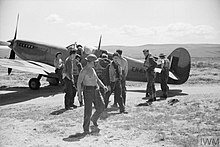Colin Falkland Gray
Group Captain Colin Falkland Gray, DSO, DFC & Two Bars (9 November 1914 – 1 August 1995) was a Royal Air Force (RAF) officer and the top New Zealand fighter ace of the Second World War.
Born in Christchurch, Gray was accepted into the RAF in 1939 on a short service commission, after two previous attempts failed on medical grounds.
He flew extensively for the majority of the Battle of Britain and by September 1940, he had shot down 14 German aircraft and had been awarded the Distinguished Flying Cross (DFC).
By 1943 he was a wing commander and flew a number of operations in the North African and Italian Campaigns and by the end of the year he had been awarded the Distinguished Service Order.
In April 1937, Gray and his brother applied for a short service commission in the Royal Air Force (RAF).
[5] During the early months of the war, the squadron alternated between Hornchurch and Rochford, carrying out patrols and being scrambled to intercept Luftwaffe aircraft.
[8] Gray achieved his first confirmed enemy aircraft, a Bf 109, the next day while escorting a formation of Fairey Swordfish to dive-bomb Gravelines.
His Spitfire received numerous cannon strikes in the engagement, and damage to the port aileron forced the aircraft into a dive that was controlled only with great difficulty.
It returned to Hornchurch on 4 June and spent most of the month flying reconnaissance patrols into France and Belgium, monitoring the activities of the Germans.
[11] The first phase of the Battle of Britain commenced on 10 July 1940, when Luftwaffe attacks on targets along the coast of England and on shipping were stepped up in the Kanalkampf (Channel war).
11 Group, which had been given the task of defending South Eastern England, Gray's squadron was heavily involved in the Battle of Britain.
[10][16] The next day, 25 July, he claimed a probable Bf 109 that was escorting a group of Junkers Ju 87 dive bombers attacking a convoy off Dover.
He soon added to his tally of victories, shooting down a pair of Bf 109s on 12 August, one near Dover and the other over Cap Gris-Nez, where it crashed onto a beach.
[18][19] On the morning of 18 August, he shared in the destruction of a Messerschmitt Bf 110 heavy fighter and damaged a Dornier Do 17 bomber on a second sortie.
With one of the He 111s having both its engines set ablaze by Gray's machine gun fire, he dove away out of ammunition but found his Spitfire had been damaged and his ailerons were inoperative.
Flying another Spitfire the same day, he had to make a forced landing when his engine was damaged following an encounter with Bf 109s over Biggin Hill.
[24] At this stage of the war, Gray had accounted for 14½ enemy aircraft destroyed and was one of only four pilots who had been with the squadron when it began operating from Hornchurch in May.
1 Squadron began operating from Tangmere, where its duties involved the protection of Allied shipping but it was also engaged in training for night interceptions.
Flight Lieutenant Gray has always shown the greatest keenness and enthusiasm and has been of great assistance to his squadron commander.
It soon shifted to north and switched to a patrol role, monitoring the east coast of England until early 1942, when it moved to Kings Cliffe.
Its work included escorting the early bombing raids carried out by Boeing B-17 Flying Fortresses of the United States Eighth Air Force.
Gray soon encountered the enemy; flying from Bone on 31 January 1, he led a group of Spitfires in an interception of a raid on Cap Negro.
[34][36] At the end of the month, he shot down another Bf 109, observing its pilot bail out after he scored hits at the wing root of the enemy aircraft.
At the time, it was reported that his victim was the German flying ace Friedrich-Karl "Tutti" Müller but in fact it was another pilot with the same surname.
[1][40] Gray's acting rank of squadron leader was made substantive on 1 September 1943 and shortly afterwards he relinquished command of No.
Within a few months, he was appointed commander of the Lympne Wing, which carried out offensive operations and escort missions to France and the occupied Netherlands.
[49][50] Gray returned to New Zealand on secondment to the RNZAF in July 1945 for several months although most of this period was spent on leave.
Back in England by March 1946 after the end of his secondment, Gray was promoted to acting wing commander, which was made substantive the following year, and posted to the Air Ministry to serve in the Directorate of Accidents Prevention.
[48][51] In January 1950, Gray was sent to Washington, D.C. as an air liaison officer to the Joint Services Mission United States.
[54] He died in Kenepuru Hospital, Porirua, on 1 August 1995, survived by his wife, Betty, whom he had married in October 1945, and his four children and a stepdaughter.


